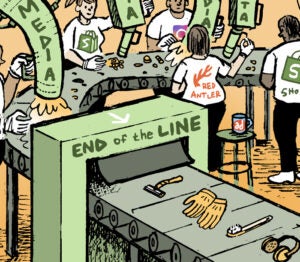 “Data-Driven Thinking” is written by members of the media community and contains fresh ideas on the digital revolution in media.
“Data-Driven Thinking” is written by members of the media community and contains fresh ideas on the digital revolution in media.
Today’s column is written by Tom O’Regan, CEO at Madison Logic.
The marketing technology landscape is bloated. Scott Brinker’s super graphic shows a whopping 1,876 vendors across 43 categories. Marketing tech stacks tower with layers of point solutions, with an average of 17 tools per stack. That’s just crazy.
We’ve reached a point of super-saturation. I anticipate the pool will soon start to shrink while at the same time, the number of tools in the stack dwindle as technologies take on double-duty.
ROI will drive this shift. As the mar tech landscape matures, the tech firms that survive will be those that deliver real value, based on guaranteed business outcomes. The tools that can increase transactions and drive revenue will rise to the top, edging out the players with less concrete benefits.
“We are clearly seeing a movement away from media proxies,” Terry Kawaja, founder and CEO at LUMA Partners, told me recently. “Marketers are increasingly insisting on paying for results rather than impressions, or any other proxy for that matter. Companies that have deep audience data like Facebook can afford to take on this challenge, which raises the bar for other publishers and will further ignite the need for identity, analytics and attribution solutions that is driving the current mar tech wave.”
The maturation of the mar tech stack will likely occur at the expense of the ad tech stack. In a recent article, Dave Morgan at Online Spin predicted that marketing technology would “eat” ad tech.
“The power in the media and marketing world is shifting from serving intermediaries to serving principals,” he wrote. “[It’s moving] from delivering media outputs for agencies to guaranteeing business outcomes for marketers, from serving agency trading desks to serving marketer enterprises. And, unfortunately, most ad tech today is anchored on the wrong side of those shifts.”
Ad tech has grown on the backs of vendors making claims of huge reach or an abundance of impressions at low prices. Reach and impressions are attractive, but how useful are they for businesses? How can reach and a million impressions positively impact the bottom line?
In the B2B space, there is growing demand for performance benchmarks. CMOs must prove their budgets are well spent and show the return for every dollar. While the ad tech industry has in the past seen healthy growth thanks to brand metrics, such as increased favorability and brand lift, as we move forward those metrics must correlate directly to increased sales.
Marketing technology, on the other hand, sits closer to the marketer. That means fewer middlemen and more focus on measurable results. Mar tech favors CMOs over intermediaries by delivering measurable, meaningful business results. One example is conversion-focused, marketing automation platforms, which are fueled by marketers and data to deliver results that map directly to the customer journey. They don’t just drive brand lift, they deliver results that lead to conversions and transactions. They fill the funnel and positively impact the bottom line. They are measurable and accountable.
AdExchanger Daily
Get our editors’ roundup delivered to your inbox every weekday.
Daily Roundup
As we see marketers getting smarter with technology and data, the tech players that support business goals will begin to outnumber vestigial point players. I believe most of those winners will sit on the mar tech side of the wall, along with some notable exceptions on the ad tech side.
In the end, the tech companies that drive measurable results will win the day, while the shiny objects fizzle into obscurity. It’s a natural evolution: the things we need stay, adapt and improve; the things we don’t need will disappear. The ecosystem of vendors and suppliers will shrink as the heartier players either absorb or squeeze out the weaker ones.
And, as a result, that giant marketing stack should shrink to the strongest players, allowing marketers, along with their tech partners, to focus on the results.
Follow Madison Logic (@madisonlogic) and AdExchanger (@adexchanger) on Twitter.












